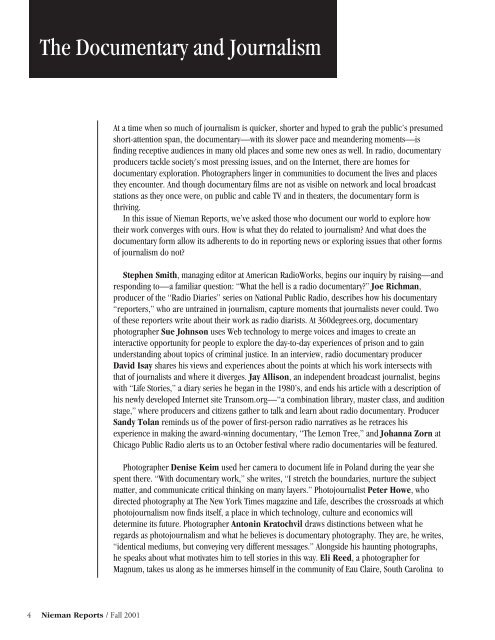Download - Nieman Foundation - Harvard University
Download - Nieman Foundation - Harvard University
Download - Nieman Foundation - Harvard University
You also want an ePaper? Increase the reach of your titles
YUMPU automatically turns print PDFs into web optimized ePapers that Google loves.
The Documentary and JournalismAt a time when so much of journalism is quicker, shorter and hyped to grab the public’s presumedshort-attention span, the documentary—with its slower pace and meandering moments—isfinding receptive audiences in many old places and some new ones as well. In radio, documentaryproducers tackle society’s most pressing issues, and on the Internet, there are homes fordocumentary exploration. Photographers linger in communities to document the lives and placesthey encounter. And though documentary films are not as visible on network and local broadcaststations as they once were, on public and cable TV and in theaters, the documentary form isthriving.In this issue of <strong>Nieman</strong> Reports, we’ve asked those who document our world to explore howtheir work converges with ours. How is what they do related to journalism? And what does thedocumentary form allow its adherents to do in reporting news or exploring issues that other formsof journalism do not?Stephen Smith, managing editor at American RadioWorks, begins our inquiry by raising—andresponding to—a familiar question: “What the hell is a radio documentary?” Joe Richman,producer of the “Radio Diaries” series on National Public Radio, describes how his documentary“reporters,” who are untrained in journalism, capture moments that journalists never could. Twoof these reporters write about their work as radio diarists. At 360degrees.org, documentaryphotographer Sue Johnson uses Web technology to merge voices and images to create aninteractive opportunity for people to explore the day-to-day experiences of prison and to gainunderstanding about topics of criminal justice. In an interview, radio documentary producerDavid Isay shares his views and experiences about the points at which his work intersects withthat of journalists and where it diverges. Jay Allison, an independent broadcast journalist, beginswith “Life Stories,” a diary series he began in the 1980’s, and ends his article with a description ofhis newly developed Internet site Transom.org—“a combination library, master class, and auditionstage,” where producers and citizens gather to talk and learn about radio documentary. ProducerSandy Tolan reminds us of the power of first-person radio narratives as he retraces hisexperience in making the award-winning documentary, “The Lemon Tree,” and Johanna Zorn atChicago Public Radio alerts us to an October festival where radio documentaries will be featured.Photographer Denise Keim used her camera to document life in Poland during the year shespent there. “With documentary work,” she writes, “I stretch the boundaries, nurture the subjectmatter, and communicate critical thinking on many layers.” Photojournalist Peter Howe, whodirected photography at The New York Times magazine and Life, describes the crossroads at whichphotojournalism now finds itself, a place in which technology, culture and economics willdetermine its future. Photographer Antonin Kratochvil draws distinctions between what heregards as photojournalism and what he believes is documentary photography. They are, he writes,“identical mediums, but conveying very different messages.” Alongside his haunting photographs,he speaks about what motivates him to tell stories in this way. Eli Reed, a photographer forMagnum, takes us along as he immerses himself in the community of Eau Claire, South Carolina to4 <strong>Nieman</strong> Reports / Fall 2001
















